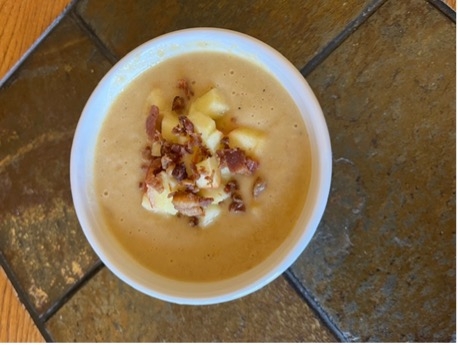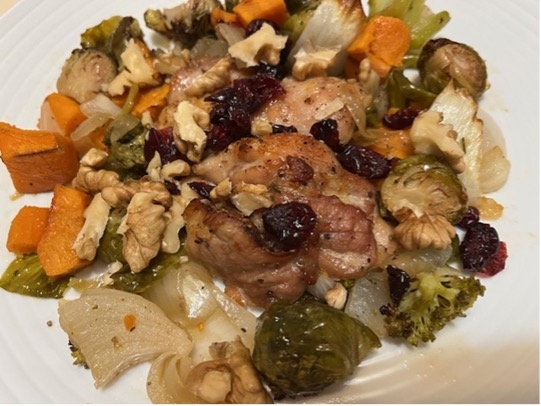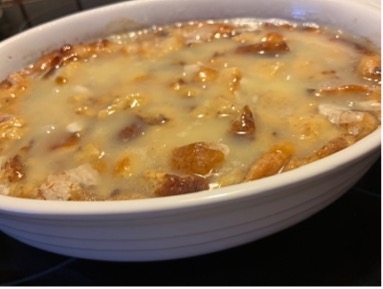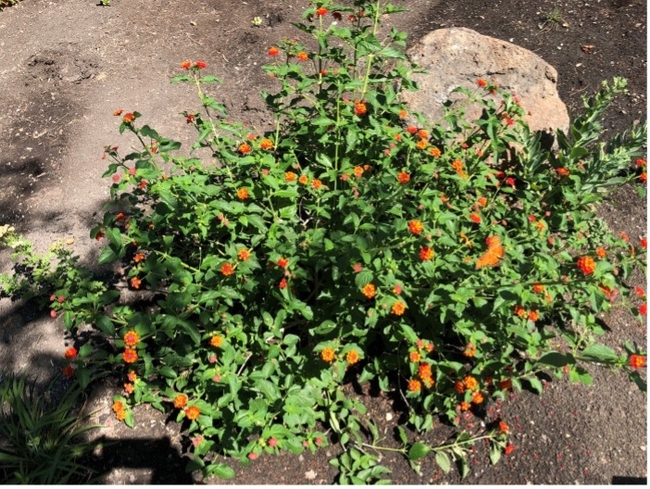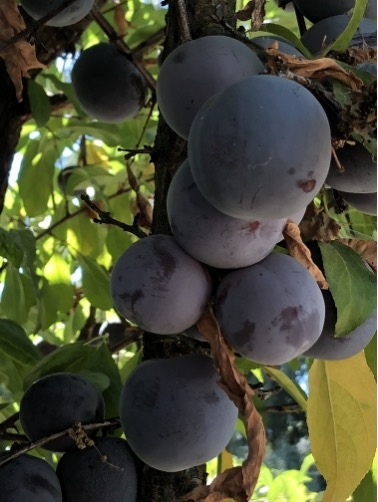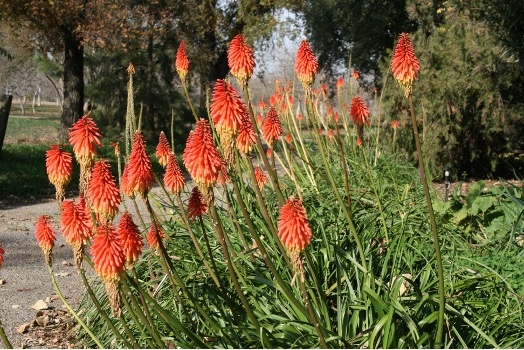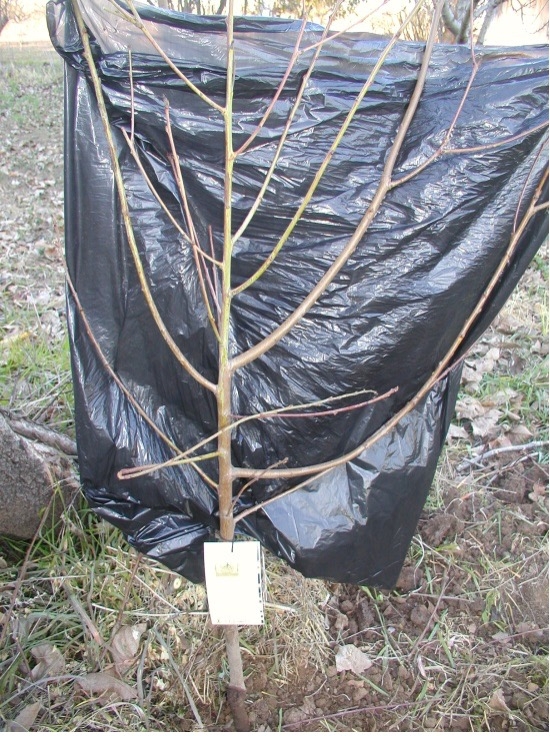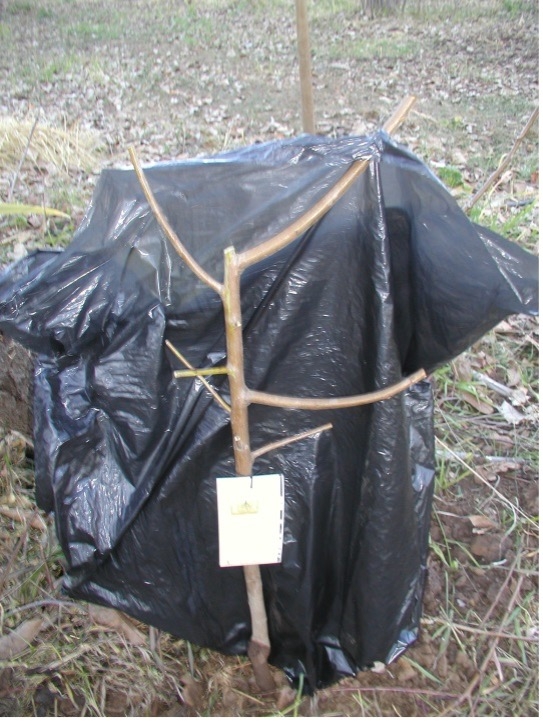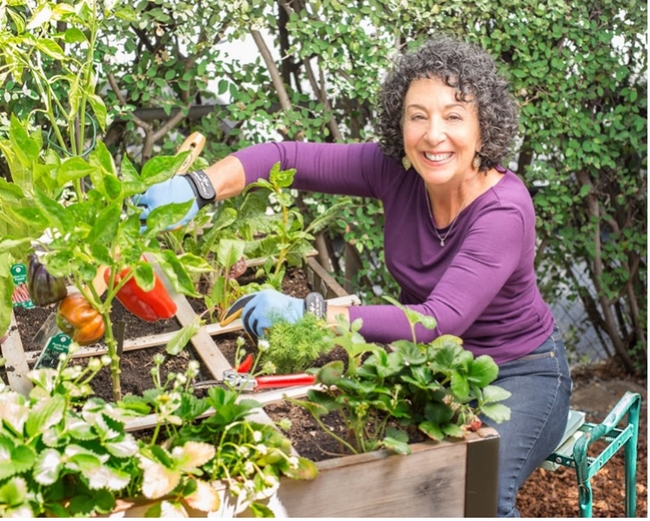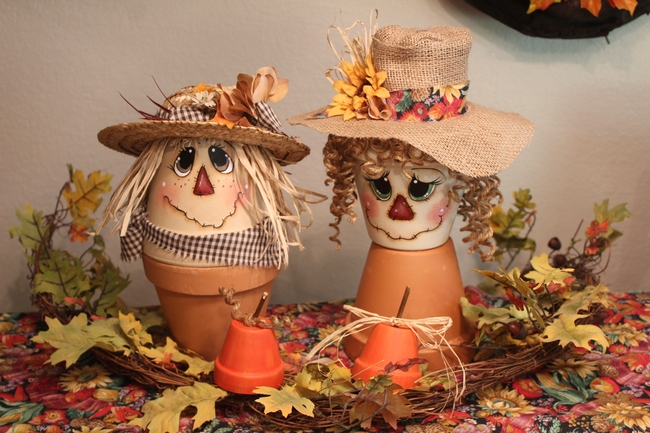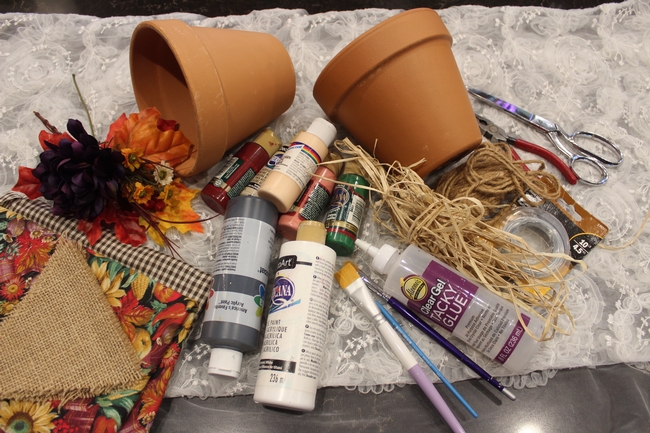- Author: Julie Hyske, Master Gardener
It's time to gear up for shorter days, longer nights and pumpkin-spice everything! Cranking up the oven is finally sounding like a good idea. Fall lends itself to comforting heartier dishes that are inspired by fall produce, like apples, sweet potatoes, squash, and root vegetables. It is time to be inspired by autumn's flavors. Each of these recipes is easy enough for even the busiest of schedules and will tide you over until wintertime.
The apple scalloped potatoes make a perfect side dish for your favorite pork chops; if company is coming just double the recipe in a larger cast-iron skillet. This silky butternut squash soup gives you the option of cutting up your home-grown squash or choosing the convenience of pre-cut cubed butternut squash. By adding the crumbled bacon and diced apple, it will be a memory maker for fall entertaining. The cheese and garlic biscuits make the perfect accompaniment to your soup or any of your comforting fall dinners. Fall is the perfect time for sheet pan meals and the maple-roasted chicken thighs with the caramelized vegetables, bright tart dried cranberries and chopped walnuts for crunch make a delicious autumn dinner. Saving the best for last is an easy recipe that salutes the revival of bread pudding. You get to choose your favorite bread; just be sure it is stale and the vanilla cream sauce is literally the frosting on the cake. I hope these recipes will inspire you to a fall seasonal refresh of one of the best times of the year!
Apple Scalloped Potatoes
Ingredients
1 medium Granny Smith apple, peeled and thinly sliced
1 tsp. sugar
1 tsp. lemon juice
2 Tbsp. butter
½ cup sliced sweet onion
5 medium red potatoes (about 1 pound), thinly sliced
1 cup shredded Parmesan cheese, divided
¾ cup heavy whipping cream
½ tsp. minced fresh thyme
½ tsp. salt
½ tsp. pepper
6 bacon strips, cooked and crumbled
Chopped fresh parsley, optional
Preheat oven to 350°F. In a small bowl, combine apple slices, sugar, and lemon juice; toss to coat. Set aside. In an 8- or 9-in. cast iron or other ovenproof skillet, heat butter over medium heat. Add onion; cook and stir until crisp-tender, about 3 minutes. Remove from the heat. Alternately arrange potato and apple slices in a single layer in the same skillet. Combine ¾ cup Parmesan cheese with cream, thyme, salt, and pepper; pour over top. Bake uncovered 50 minutes. Top with bacon and the remaining ¼ cup Parmesan cheese. Bake until potatoes are tender and top is lightly browned, 5-10 minutes longer. Let stand for 10 minutes before serving. If desired, sprinkle with parsley.
Serves 4
Autumn Butternut Squash Soup
Ingredients
3 lbs. cubed butternut squash
1 medium onion, halved and sliced into wedges
4 cloves garlic, peeled
1 tsp. sea salt
½ tsp. freshly ground black pepper
3 Tbsp. avocado oil or another heat-safe oil
3 cups chicken broth or more, as needed
1 cup heavy cream
Optional: diced apple and crumbled, cooked bacon
Preheat oven to 425ºF. Put squash cubes, onion, and garlic cloves on a large, rimmed baking sheet. Sprinkle with salt and pepper and drizzle oil over top. Use your hands to toss everything around so it's evenly coated. Roast for 35–40 minutes on a lower oven rack, tossing things around with a spatula a couple of times during cooking. Transfer roasted items to a medium to large soup pot. Add chicken broth and heat to a simmer. Let it simmer for about 5 minutes and then blend it with an immersion blender (or in batches with a counter-top blender) until smooth. Stir in cream. Add a little more salt, if needed, before serving. Top with diced apple and crumbled, cooked bacon, if desired.
Serves 4
Cheese and Garlic Biscuits
Ingredients
2 ½ cups biscuit/baking mix
¾ cup shredded sharp cheddar cheese
1 tsp. garlic powder
1 tsp. ranch salad dressing mix
1 cup buttermilk
Topping:
½ cup butter, melted
½ tsp. garlic powder
½ tsp. ranch salad dressing mix
Everything but the Bagel seasoning
In a large bowl, combine the baking mix, cheese, garlic powder and salad dressing mix. Stir in buttermilk just until moistened. Drop by tablespoonfuls onto greased baking sheets or parchment lined sheets. Bake at 375? until golden brown, 6-8 minutes. Meanwhile, combine topping ingredients. Brush over biscuits when removed from oven. Sprinkle with Everything but the Bagel. Serve warm.
Makes 1½ dozen
Honey Maple Roasted Chicken Thighs
Ingredients
1/3 cup honey
¼ cup maple syrup
1 Tbsp. snipped fresh thyme
4 Tbsp. olive oil, divided
1 Tbsp tsp. salt, divided
1 Tbsp. ground black pepper, divided
1½ lbs. sweet potatoes, peeled and cut into 1-inch wedges
1½ lbs. Brussels sprouts, trimmed and halved
1 large yellow onion sliced
1 medium crown of broccoli, flowerets separated
6 boneless skinless chicken thighs
½ cup chopped toasted walnuts
¾ cup chopped dried cranberries
Preheat the oven to 400ºF. Line a 10x15-inch baking pan with foil. Whisk together honey, maple syrup, thyme, 1 Tbsp. olive oil, 1 tsp salt, and 1 tsp pepper in a small bowl. Set aside. Toss together sweet potatoes, Brussels sprouts, onion and broccoli. Add 1 Tbsp. olive oil, 1 tsp. salt, and 1 tsp. pepper in a large bowl. Set aside. Brush chicken with the remaining 2 Tbsp. olive oil; sprinkle with remaining teaspoon salt and teaspoon pepper. Arrange chicken in the center of the prepared pan. Arrange sweet potato mixture around chicken. Roast in the preheated oven for 15 minutes. Turn chicken over, brush chicken, sweet potatoes, and Brussels sprouts with maple syrup mixture. Continue to roast until sweet potatoes are tender and chicken is no longer pink in the center and the juices run clear, about 20 minutes. Sprinkle with walnuts and cranberries to serve.
Serves 6
Bread Pudding
Ingredients
2 cups half and half
2 Tbsp. softened butter
1 tsp. vanilla extract
1/3 cup granulated sugar
pinch of salt
4 eggs, beaten
½ tsp. ground cinnamon
1 loaf day old bread cut into 1-inch cubes, about 7 cups (I used cinnamon rolls)
Vanilla Cream Sauce:
1 cup granulated sugar
½ cup butter (1 stick)
1 cup heavy whipping cream
2 tsp. vanilla extract
Heat oven to 350ºF. In a large bowl add half and half, softened butter, vanilla, sugar and salt. Add the beaten eggs and cinnamon to the milk mixture and whisk well to combine. Add the bread to the bowl and stir to coat. Pour the mixture into a greased baking dish large enough to fit (any shallow casserole dish; I used a 7×11-inch pan). Bake for 30 to 45 minutes, or until custard is set but still a little wobbly and edges of bread have lightly browned. Serve warm or at room temperature. Drizzle with vanilla cream sauce, if desired.
For the Vanilla Cream Sauce:
Add sugar, butter, and cream to a medium saucepan over medium heat. Cook, stirring occasionally, until butter has melted. Bring mixture to a boil stirring frequently, for 3-5 minutes. Remove from heat and add vanilla.
Allow to cool for a few minutes and thicken before pouring over the bread pudding.
Serves 6-8
- Author: Lee Miller, UCCE Master Gardener
Plants to Enjoy
Lantana, the Laroda plum tree, and Red Hot Poker are just a few of my favorite plants in my ¾-acre garden.
SHRUB: Although there are 150 different species of lantana, those most widely available to home gardeners are Lantana camara and modern hybrids. A member of the verbena family, lantana is native to tropical regions of the Americas and South Africa. This small tropical shrub has lots of small flower clusters that come in a rainbow of single and multiple hues. It is perennial in climate zones 9 to 11 and can be an annual in colder climates unless it is brought inside in the fall. In our zone 9, it blooms nearly year around. The flowers attract butterflies, hummingbirds, and insect pollinators.
It can be pruned back in the spring by one third. It thrives in hot, dry weather and does best in 6 to 8 hours of full sun. It tolerates various soils but does best in rich, well-drained soil. It is usually a short 2- to 3-foot shrub but can reach 6 feet tall and 3 to 10 feet wide. While it can be grown in containers, I recently moved a container-grown plant into the ground, where it grew much larger and bloomed more vigorously. I have another container-grown one that I will plant in the ground soon because the results of the first one were so impressive. I have since bought four more to add to my collection.
TREE: The Laroda plum has an extraordinary wine-like flavor and is considered by some to be one of the best tasting Japanese plums. The flesh is amber with streaks of red on the inside. The texture is firm with high sweetness, balanced with just the right amount of acidity. It has received high overall scores in taste testings for its sweet, excellent flavor. A dark purple plum similar to the Santa Rosa,Laroda is larger and ripens about a month later and has a long harvest, which begins in mid-July and extends into mid-August. Unlike Santa Rosa plums, Laroda plums tend to stay on the tree even after ripening, which extends harvest time. The tree is vigorous and upright. This mid-season bloomer requires a pollinizer such as Santa Rosa or Catalina. When I moved to my new home in 2017, I grafted a flowering plum and a rootstock sprout to Laroda and Elephant Heart plums. The Elephant Heart grafts failed and and so I now have two trees that produce baskets of Laroda plums beyond belief.
PERENNIAL FLOWER: Red Hot Poker (Kniphofia) is a genus of about 70 species of evergreen or herbaceous perennials prized for their tall, show-stopping flower spikes in bright red, orange, and yellow. The evergreen species feature linear, strap-shaped, basal leaves and showy bottlebrush-like flower spikes. The herbaceous species have narrow, grass-like leaves. The genus is native to mountainous areas in southern to tropical Africa. Plant size ranges from dwarf to 1-1/2 feet tall, with some species reaching 6 feet tall. The genus name honors Johann Hieronymus Kniphof (1704-1763), a German physician and botanist.
Red Hot Poker prefers a rich, well-drained, moist soil in full sun. Light shade is helpful if summers are hot, and the plant should be sited in a location protected from wind. It will do well in sandy soils but is less tolerate of clay. When flowers fade, simply cut them away from the stem with garden shears about one-half inch below the flowers. This plant is slightly salt tolerant. It is attractive to hummingbirds, bees, and butterflies but, fortunately, not to deer or rabbits. Plants can be propagated by seed, or, for named cultivars, by division in the spring. See this website for more information on growing and managing this plant.
- Author: Lee Miller, Master Gardener
A Question from the Help Desk – New Fruit Trees
Question: I am buying some fruit trees this fall for a small backyard orchard. What trees are best to buy and how do I prune the trees to get them started correctly?
This is a great question and I have had a lot of experience with backyard fruit trees. I can tell you a bit about my experience in selecting what trees to grow.
Selecting a Tree
The tree that I most enjoy is the Red Haven peach tree, which is excellent for backyards. It starts to produce early and the fruit does not ripen all at once, as happens with many peaches such as the Elberta variety. The season for Red Haven peaches is nearly a month long starting in late June. The only problem is that you need to assess which peaches are ripe and ready for picking. This process can be somewhat time consuming but it is worth the effort. Plums are also a good backyard fruit tree; Santa Rosa, Satsuma, and Laredo are all good varieties. I prefer the Laredo as it has a longer ripening season, which starts in late July and extends to about September 1. The plums are delicious. The Santa Rosa plum, like most peaches, has a short season and the plums fall off after 2 to 3 weeks of availability. The Satsuma plum is a large, firm plum with red flesh and is a good cooking plum for jams or canning as well as eating fresh. It does well in the Central Valley and ripens in August.
Citrus are also an excellent choice for the Central Valley as many varieties can be grown. Lemons, oranges, grapefruit and tangerines can be all be enjoyed in our mild climate. They are relatively trouble free and provide very useful fruit.
Growing apples in the backyard is a bit trickier as codling moth is a common pest that will need to be dealt with. Apples and pears are also vulnerable to fire blight. Several dwarfing apple rootstocks are available, which makes it easy to grow small trees in a backyard orchard. Cherries are another fruit that can be grown in the backyard, and they can be kept to 8 feet tall on dwarfing rootstock. I would avoid buying multi-grafted trees as one or two of the grafts will become dominant.
The First Pruning
To start out your orchard trees properly, it is important to prune them after planting. For most semi-dwarf or standard trees, they need to be pruned with a heading cut to start them on their way correctly. This first pruning can look brutal, but it is essential.
The heading cut—in the range of 20 to 30 inches from the ground—will not only encourage the development of scaffold branches but also open up the center of the tree to develop a vase or bowl shape that allows the sun into the center to help ripen fruit. A tree with 3 to 4 scaffold branches, which should also be headed back, is the desired result. Almonds, apricots, peaches, cherries, plums, and prunes all do best with a vase-shaped tree with an open center.
A young new bare-root peach tree before and after the initial pruning:
Apples can also be trained in this manner. However, apples, Asian pears, European pears, figs, persimmons, and quinces are more often trained to a central leader. With a central leader, a heading cut is not done. Instead the central leader is allowed to grow and dominate the tree.
For more information on pruning backyard fruit trees see this UC Davis site.
Good luck with your new backyard orchard venture!
- Author: John Giehl, Master Gardener
The Lifelong Gardener, by Toni Gattone, offers lots of practical information on gardening as we age. The author is retired from the garden manufacturing industry with four decades of experience. She is also a certified UC Master Gardener in Marin County, CA, with 15 years' experience and one “bad back.”
The Lifelong Gardener is organized into three sections: 1) Your Body, 2) Your Garden, and 3) Your Tools. The book is quite readable with many photos, graphs, checklists, and illustrations. It is sprinkled with insightful adages from the likes of Dalai Lama, Mark Twain and Oliver Wendell Holmes.
Part I: Your Body contains many memorable quotes. Among them are: “Old is how you feel rather than your age” (p. 25), “Life is not about how long you live but how well” (p. 23), “We change our attitude by changing our perspective” (p. 250), “A project done is better than a perfectly done project” (p. 28), and “Resilience is our ability to adapt/recover from setback” (p. 28).
The first step in gardening and growing older is needing to accept our age-related limitations. We have shorter periods of sustained energy (30 minutes max), balance can be an issue (beware of heights), arthritis affects many of us (try electric- or battery-powered tools), lower-back issues plague many (work in elevated beds when possible), and strength is lessened (delegate assistance with heavy objects). Other issues include mobility, reaction time, compromised vision, temperature sensitivity, and thin skin bruising (senile purpura).
Seniors should do a bend and stretch warm-up for the benefit of muscles and joints prior to working in the garden. Gardening can implicate every muscle group as well as the joints in the spine, fingers, feet, neck, hips, knees, and legs.
Remember, repetitive motion invites stress injuries so frequently rotate the activity and the muscle group being used. For example, try a little pruning, followed by a little bending or squatting, next raking, some weeding, then sweeping, and finishing with potting plants and/or seedlings. The upside of daily physical activity in a garden is that it can reduce stroke, heart attack, and death by 28%.
Part II: Your Garden notes that a garden's layout or design may need modification. Plant selection should favor succulents, long-blooming shrubs and flowers, and pest- and drought-resistant cultivars. Consider plant longevity in the selections (fewer annuals, and more biennials and perennials). Design with your hydrozone in mind, grouping plants with similar needs for water, sun, and soil. Group pollinator plants in threes.
Consider grasses, which are both colorful and hardy. Herbs (parsley, rosemary, marjoram, basil, mint, sage, and thyme) provide a flavorful practical complement. They are characterized by low maintenance, yet are tolerant of poor soil, and some are drought resistant. Edible flowers such as cornflower, nasturtium, hibiscus, honeysuckle, pansy, and cape jasmine add brightness to the garden as well as the table. Bulbs are perennial and low maintenance. A short, thick groundcover can help block weed proliferation. The Sunset Western Garden Book is a credible reference for many types of plants and their needs.
Here are some types of gardening to consider as the transition to a more manageable garden is taking place:
- Container gardening. Its benefits include accessibility, lessened discomfort, easy maintenance (water and weeds), and fewer insect problems. Containers can be durable: ceramic, galvanized, fiberglass resin, terra cotta, cages, baskets, or even a wooden wine barrel.
- Raised bed gardening. A waist-high bed is more manageable, easier to water, and easier to control for weeds and pests.
- Vertical gardening. Some people downsize their place of residence with age. In adjusting to this new reality, consider a trellis, fence, wall, railing planter, balcony deck, window box, pergola, or arbor. Any of these could be part of a solution to surrendering our horizontal space.
Part III: Your Tools or Gear notes that protective eyewear or sunglasses, long sleeves, long pants, and a broad-brimmed hat are essential gardening apparel for everyone, not just senior gardeners. The right tools are needed for each and every task to accommodate for physical well-being and comfort issues or limitations that result from aging. There are many online and printed resources that evaluate and recommend various gardening accommodations and adjustments for the older gardener. Items approved and suggested are ergonomically designed for stress reduction. A partial list of instrumental accoutrement includes:
- Portable garden seat with a detachable tool bag
- Plastic watering can that is both lightweight and balanced
- Good tool sharpener with a comfort grip
- Retractable hose
- Kneeler that reverses to a seat
- Comfortable knee pads
- Stand-up weeder and/or a cobra head weeder/cultivator with an ergonomic grip
- Expandable (7- to 21-inch) tined rake with a telescopic handle
- Reusable debris bag that can be easily lifted when full
- Multifunctional trowel
- Good-quality, double-stitched gloves with reinforced fingertips and (if possible) padded palms that are light, washable, and durable. Gauntlet gloves that extend from the hand up the arm to protect the wrist and forearm are nice to have if there are thorny bushes in the landscape.
In summary, to be a successful lifelong gardener, use gentle stretches and mindful work to help care for the body, take a careful look at the garden landscape and redesign however possible to make upkeep easier, and use the right tools to make the job less stressful on both mind and body.
Clay pots aren't just for growing your plants anymore. With some creativity and craft supplies, they can be transformed into fun home and garden decorations.
Clay pots, also referred to as terra cotta planters, make wonderful containers for outdoor potted plants or houseplants indoors. Terra cotta planters are made from a natural clay, usually orange, or a red and brown mix of colors. They are formed into a variety of shapes and then heated to high temperatures, which makes the clay rigid and strong. They are porous, which helps prevent overwatering and makes them an excellent choice for most plants. They come in a wide variety of sizes and are affordable.
These flower pot containers have become increasingly popular to use for all kinds of craft projects. They can be painted, decoupaged, used for making mosaics plus many other options. Creative and endless ideas can be found on the internet, many with how-to tutorials. They can be decorated to fit the colors and theme of a room or holiday. Fall is a favorite time of year to create seasonal decorations using pots. Scarecrows are a familiar sight to see as fall approaches. Scarecrows were originally made to help farmers protect their fields from hungry birds that ravaged their crops. Today, they add whimsy to home gardens and are cute decorations for the home.
To make a clay-pot scarecrow, you will need:
- Clay pot, size of your choice. I used a 6-inch pot.
- Paint and brushes. I used a creamy tan color. Also black, green, pink, dark red and white.
- For the hat, I used one store bought and constructed the other using craft supplies including burlap.
- For the hair, I used raffia and jute twine. For curly hair, wind either material around a thin dowel in a single layer, put in water for a minute, place on a pan, then dry on the lowest setting (170 degrees) in the oven. Twine will take about 30 minutes to be totally dry. Raffia will take about 10 minutes. Keep a close eye on the oven while drying.
- You will also need frayed fabric, fake flowers, glue, wire, wire cutters and scissors.
Paint the pot with several coats to get full coverage. I would recommend placing the pot upside down before penciling on the facial features and then paint using colors of your choice. (The bottom will be the top of his head). White, green, and black were used for the eyes, dark red for the nose, pink for the cheeks, and black for the mouth. Next, gather about 20 to 30 pieces of raffia or jute cut in about 10-inch lengths. Gather in the middle using wire. Spread them around the top to represent the hair. Glue to the bottom of pot, which is the top of the head. Glue on the hat. Tear a strip of fall-printed fabric for a hat band. Arrange and glue on flowers, a fall-color leaf, acorn, or other items of your choice. Cut a piece of fabric in a somewhat triangle shape, tie, and glue around rim of the pot to make the scarf.
These make the perfect centerpieces for the fall table along with pumpkins and other decorations. If you paint them orange, turn them upside-down to make a pumpkin. Add a dowel or twig for a stem. Stack painted pots beneath the scarecrow face to represent his body. The scarecrow pot can be set onto a post and placed into the garden or he can greet your guests by the front door. They can be transformed into delightful decor for everyday and seasonal use with a bit of imagination. Look to the internet for some inspiration. Gather up your friends and get crafting together for some fall fun!



